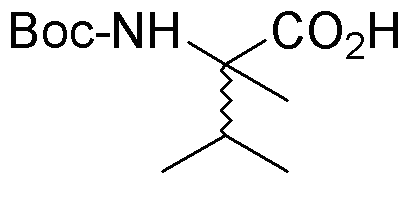Boc-a-methyl-DL-Valine is widely utilized in research focused on:
- Peptide Synthesis: This compound serves as a protective group in the synthesis of peptides, allowing for the selective modification of amino acids. Its stability under various conditions makes it a preferred choice for researchers in the field of biochemistry.
- Drug Development: In pharmaceutical research, Boc-a-methyl-DL-Valine is used to create prodrugs that can enhance bioavailability. By modifying the compound, researchers can improve the delivery of therapeutic agents in the body.
- Protein Engineering: The compound plays a crucial role in the design of novel proteins with specific functionalities. Its unique structure allows for the incorporation of non-standard amino acids, enabling the development of proteins with enhanced properties.
- Biotechnology Applications: In biotechnology, it is used in the production of modified enzymes that can withstand extreme conditions, making them suitable for industrial processes such as biocatalysis.
- Research on Metabolic Pathways: Researchers utilize Boc-a-methyl-DL-Valine to study metabolic pathways involving branched-chain amino acids, providing insights into various metabolic disorders and potential therapeutic targets.
General Information
Properties
Safety and Regulations
Applications
Boc-a-methyl-DL-Valine is widely utilized in research focused on:
- Peptide Synthesis: This compound serves as a protective group in the synthesis of peptides, allowing for the selective modification of amino acids. Its stability under various conditions makes it a preferred choice for researchers in the field of biochemistry.
- Drug Development: In pharmaceutical research, Boc-a-methyl-DL-Valine is used to create prodrugs that can enhance bioavailability. By modifying the compound, researchers can improve the delivery of therapeutic agents in the body.
- Protein Engineering: The compound plays a crucial role in the design of novel proteins with specific functionalities. Its unique structure allows for the incorporation of non-standard amino acids, enabling the development of proteins with enhanced properties.
- Biotechnology Applications: In biotechnology, it is used in the production of modified enzymes that can withstand extreme conditions, making them suitable for industrial processes such as biocatalysis.
- Research on Metabolic Pathways: Researchers utilize Boc-a-methyl-DL-Valine to study metabolic pathways involving branched-chain amino acids, providing insights into various metabolic disorders and potential therapeutic targets.
Documents
Safety Data Sheets (SDS)
The SDS provides comprehensive safety information on handling, storage, and disposal of the product.
Product Specification (PS)
The PS provides a comprehensive breakdown of the product’s properties, including chemical composition, physical state, purity, and storage requirements. It also details acceptable quality ranges and the product's intended applications.
Certificates of Analysis (COA)
Search for Certificates of Analysis (COA) by entering the products Lot Number. Lot and Batch Numbers can be found on a product’s label following the words ‘Lot’ or ‘Batch’.
*Catalog Number
*Lot Number
Certificates Of Origin (COO)
This COO confirms the country where the product was manufactured, and also details the materials and components used in it and whether it is derived from natural, synthetic, or other specific sources. This certificate may be required for customs, trade, and regulatory compliance.
*Catalog Number
*Lot Number
Safety Data Sheets (SDS)
The SDS provides comprehensive safety information on handling, storage, and disposal of the product.
DownloadProduct Specification (PS)
The PS provides a comprehensive breakdown of the product’s properties, including chemical composition, physical state, purity, and storage requirements. It also details acceptable quality ranges and the product's intended applications.
DownloadCertificates of Analysis (COA)
Search for Certificates of Analysis (COA) by entering the products Lot Number. Lot and Batch Numbers can be found on a product’s label following the words ‘Lot’ or ‘Batch’.
*Catalog Number
*Lot Number
Certificates Of Origin (COO)
This COO confirms the country where the product was manufactured, and also details the materials and components used in it and whether it is derived from natural, synthetic, or other specific sources. This certificate may be required for customs, trade, and regulatory compliance.


